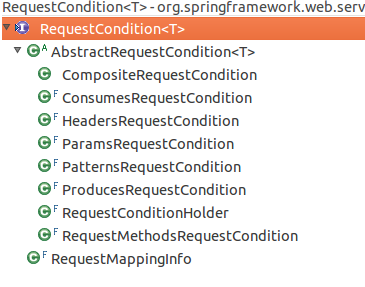SpringMVC源码解读 - RequestMapping注解实现解读 - RequestCondition体系
一般我们开发时,使用最多的还是@RequestMapping注解方式.
@RequestMapping(value = "/", param = "role=guest", consumes = "!application/json")
public void myHtmlService() {
// ...
}
台前的是RequestMapping ,正经干活的却是RequestCondition,根据配置的不同条件匹配request.
@RequestMapping注解,请看<SpringMVC源码解读 - HandlerMapping - RequestMappingHandlerMapping初始化>

典型的接口+模板.一个接口ReqeustCondition,一个抽象类,定义基础,然后n多的具体实现.
实现中可以分为3类:基础实现,外观类和容器.
其中CompositeRequestCondition和RequestMappingInfo本身不带任何的匹配条件,只是用于包装其他的RequestCondition进行匹配
基础实现:
consumes对应request的提交内容类型content type,如application/json, text/html
headers 对应http request 的请求头
params对应http request parameter
Patterns对应url,就是注解value中的配置
produces指定返回的内容类型的content type,仅当request请求头中的(Accept)类型中包含该指定类型才返回
requestMethods对应 http method,如GET,POST,PUT,DELETE等
外观类:
RequestConditionHolder,用于不知道具体是RequestCondition哪个子类时.自定义的条件,使用的这个进行封装
容器:
CompositeRequestCondition封装基础实现,具体的匹配都委托给基础实现类.
RequestMappingInfo,对应@RequestMapping注解,一一对应注解内容与基础实现,使用时一一委托.
先来看看RequestCondition的接口定义
package org.springframework.web.servlet.mvc.condition;
/**
* The contract for request conditions.
*/
public interface RequestCondition<T> { /**
* 将不同的筛选条件合并
*/
T combine(T other); /**
* 根据request查找匹配到的筛选条件
*/
T getMatchingCondition(HttpServletRequest request); /**
* 不同筛选条件比较,用于排序
*/
int compareTo(T other, HttpServletRequest request); }
}
老规矩,接下来得上抽象类AbstractRequestCondition
AbstractRequestCondition做的事不多,覆写equals,hashCode,toString.实现equals,hashCode,toString时预留模板方法getContent();实现toString时预留模板方法getToStringInfix().
package org.springframework.web.servlet.mvc.condition;
/**
* A base class for {@link RequestCondition} types providing implementations of
* {@link #equals(Object)}, {@link #hashCode()}, and {@link #toString()}.
*
* @author Rossen Stoyanchev
* @since 3.1
*/
public abstract class AbstractRequestCondition<T extends AbstractRequestCondition<T>> implements RequestCondition<T> { /**
* Return the discrete items a request condition is composed of.
* For example URL patterns, HTTP request methods, param expressions, etc.
* @return a collection of objects, never {@code null}
*/
protected abstract Collection<?> getContent(); @Override
public boolean equals(Object o) {
if (this == o) {
return true;
}
if (o != null && getClass().equals(o.getClass())) {
AbstractRequestCondition<?> other = (AbstractRequestCondition<?>) o;
return getContent().equals(other.getContent());
}
return false;
} @Override
public int hashCode() {
return getContent().hashCode();
} @Override
public String toString() {
StringBuilder builder = new StringBuilder("[");
for (Iterator<?> iterator = getContent().iterator(); iterator.hasNext();) {
Object expression = iterator.next();
builder.append(expression.toString());
if (iterator.hasNext()) {
builder.append(getToStringInfix());
}
}
builder.append("]");
return builder.toString();
} /**
* The notation to use when printing discrete items of content.
* For example " || " for URL patterns or " && " for param expressions.
*/
protected abstract String getToStringInfix(); }
接下来得看具体实现了,捏不到软柿子,用ParamsRequestCondition简单说明下子类吧
// ParamsRequestCondition
// 保存解析出来的param匹配条件
private final Set<ParamExpression> expressions;
ParamExpression其实很简单,看父类AbstractNameValueExpression很清楚
// AbstractNameValueExpression
package org.springframework.web.servlet.mvc.condition;
abstract class AbstractNameValueExpression<T> implements NameValueExpression<T> {
// 参数的名字
protected final String name;
// 参数的值
protected final T value;
// 参数的匹配规则,是= 还是!=
protected final boolean isNegated;
}
到这里我们就可以看懂,使用ParamExpression保存param参数,这样可以任意多个.
combine的实现也就水到渠成,直接把expression拼接到一个集合里就行:
package org.springframework.web.servlet.mvc.condition;
public final class ParamsRequestCondition extends AbstractRequestCondition<ParamsRequestCondition> {
/**
* Returns a new instance with the union of the param expressions
* from "this" and the "other" instance.
*/
public ParamsRequestCondition combine(ParamsRequestCondition other) {
Set<ParamExpression> set = new LinkedHashSet<ParamExpression>(this.expressions);
set.addAll(other.expressions);
return new ParamsRequestCondition(set);
}
}
getMatchingCondition时,只要有一个不符合就判定条件不匹配
package org.springframework.web.servlet.mvc.condition;
public final class ParamsRequestCondition extends AbstractRequestCondition<ParamsRequestCondition> {
/**
* Returns "this" instance if the request matches all param expressions;
* or {@code null} otherwise.
*/
public ParamsRequestCondition getMatchingCondition(HttpServletRequest request) {
for (ParamExpression expression : expressions) {
if (!expression.match(request)) {
return null;
}
}
return this;
}
}
这边的match方法比较有意思,可以看下
package org.springframework.web.servlet.mvc.condition;
abstract class AbstractNameValueExpression<T> implements NameValueExpression<T> {
public final boolean match(HttpServletRequest request) {
boolean isMatch;
if (this.value != null) {
isMatch = matchValue(request);
}
else { // 没有value时,只要匹配name就好
isMatch = matchName(request);
}
return isNegated ? !isMatch : isMatch; // 这边需要看仔细,=与!=的处理
} protected abstract boolean matchName(HttpServletRequest request); protected abstract boolean matchValue(HttpServletRequest request);
}
ParamExpression中给出matchName与matchValue的实现.
ParamExpression这里又是接口+抽象实现+模板方法设计模式,偷个懒,暂时不去关心各层抽象的什么.
compareTo根据匹配条件的多少来判定顺序
// ParamsRequestCondition
public int compareTo(ParamsRequestCondition other, HttpServletRequest request) {
return other.expressions.size() - this.expressions.size();
}
记得还留有两个模板方法
getContent直接返回记录param的expressions
getToStringInfix则使用&&
// ParamsRequestCondition
@Override
protected Collection<ParamExpression> getContent() {
return expressions;
} @Override
protected String getToStringInfix() {
return " && ";
}
再看看是如何解析param的
// ParamsRequestCondition
/**
* Create a new instance from the given param expressions.
* @param params expressions with syntax defined in {@link RequestMapping#params()};
* if 0, the condition will match to every request.
*/
public ParamsRequestCondition(String... params) {
this(parseExpressions(params));
} private static Collection<ParamExpression> parseExpressions(String... params) {
Set<ParamExpression> expressions = new LinkedHashSet<ParamExpression>();
if (params != null) {
for (String param : params) {
expressions.add(new ParamExpression(param));
}
}
return expressions;
}
核心的代码还是在AbstractNameValueExpression
// AbstractNameValueExpression
逻辑不复杂,代码看着有点烦,是不是应该听Martin Fowler在<重构>中的建议,来个extract method?
AbstractNameValueExpression(String expression) {
int separator = expression.indexOf('=');
if (separator == -1) {
this.isNegated = expression.startsWith("!");
this.name = isNegated ? expression.substring(1) : expression;
this.value = null;
}
else {
this.isNegated = (separator > 0) && (expression.charAt(separator - 1) == '!');
this.name = isNegated ? expression.substring(0, separator - 1) : expression.substring(0, separator);
this.value = parseValue(expression.substring(separator + 1));
}
}
RequestCondition的解读未完,待续:
SpringMVC源码解读 - RequestMapping注解实现解读 - ConsumesRequestCondition
SpringMVC源码解读 - RequestMapping注解实现解读 - RequestMappingInfo
SpringMVC源码解读 - RequestMapping注解实现解读 - RequestCondition体系的更多相关文章
- SpringMVC源码解读 - RequestMapping注解实现解读 - RequestMappingInfo
使用@RequestMapping注解时,配置的信息最后都设置到了RequestMappingInfo中. RequestMappingInfo封装了PatternsRequestCondition, ...
- SpringMVC源码解读 - RequestMapping注解实现解读
SpringMVC源码解读 - RequestMapping注解实现解读 - RequestCondition体系 https://www.cnblogs.com/leftthen/p/520840 ...
- SpringMVC源码解读 - RequestMapping注解实现解读 - ConsumesRequestCondition
consumes 指定处理请求的提交内容类型(media-Type),例如application/json, text/html. 所以这边的ConsumesRequestCondition就是通过 ...
- SpringMVC源码阅读系列汇总
1.前言 1.1 导入 SpringMVC是基于Servlet和Spring框架设计的Web框架,做JavaWeb的同学应该都知道 本文基于Spring4.3.7源码分析,(不要被图片欺骗了,手动滑稽 ...
- SpringMVC源码解读 - HandlerMapping
SpringMVC在请求到handler处理器的分发这步是通过HandlerMapping模块解决的.handlerMapping 还处理拦截器. 先看看HandlerMapping的继承树吧 可以大 ...
- SpringMVC 源码深度解析<context:component-scan>(扫描和注冊的注解Bean)
我们在SpringMVC开发项目中,有的用注解和XML配置Bean,这两种都各有自己的优势,数据源配置比較经经常使用XML配置.控制层依赖的service比較经经常使用注解等(在部署时比較不会改变的) ...
- 7、SpringMVC源码分析(2):分析HandlerAdapter.handle方法,了解handler方法的调用细节以及@ModelAttribute注解
从上一篇 SpringMVC源码分析(1) 中我们了解到在DispatcherServlet.doDispatch方法中会通过 mv = ha.handle(processedRequest, res ...
- SpringMVC源码情操陶冶-AnnotationDrivenBeanDefinitionParser注解解析器
mvc:annotation-driven节点的解析器,是springmvc的核心解析器 官方注释 Open Declaration org.springframework.web.servlet.c ...
- SpringMVC源码剖析5:消息转换器HttpMessageConverter与@ResponseBody注解
转自 SpringMVC关于json.xml自动转换的原理研究[附带源码分析] 本系列文章首发于我的个人博客:https://h2pl.github.io/ 欢迎阅览我的CSDN专栏:Spring源码 ...
随机推荐
- [Cpp primer] Library string Type
In order to use string type, we need to include the following code #include<string> using std: ...
- 关于C++成员函数指针的使用
在做项目的时候,遇到了在类中根据不同的调用函数,在被调用函数的某处需要做不同的处理,本来就想着直接在类中设个标记变量判断下就好了,不过觉得这样代码可能看起来会有些凌乱,而且效率估计有些低,于是想起来使 ...
- halcon采集一幅图像
**顺序也很重要,必须现有窗口,才能设置属性 dev_close_window()dev_open_window (0, 0, 1400, 1200, 'black', WindowHandle)de ...
- Django templates 和 urls 拆分
如果在Django项目 下面新建了blog和polls两个APP应用,在每个APP下面都各自新建自己的url和templates,那么我们需要如何进行项目配置呢? INSTALLED_APPS = [ ...
- Sublime Text:初学者不知道的那些事
来源:Duchessjojo@译言 我是Sublime Text代码编辑器的忠实粉丝.我和诸多Mac程序员一样,最初使用的是Textmate代码编辑器.在Sublime Text 2发行后,我才开始转 ...
- sublime 安装插件
安装Package Control 在安装插件之前,需要让sublime安装Package Control.打开Sublime Text的控制台,快捷键ctrl + ~,在控制台中输入以下代码. im ...
- redis 批量删除键
主题 为啥会有这篇文章呢? 在redis里我需要批量删除一些 "特殊" 的数据...这些特殊的数据用正常方法比较难删除...所以记录一下我的删除方法.. 背景与问题 我再用Spri ...
- PHP 数组中出现中文乱码,json_encode返回结果为null 或false
想要解决这个问题,没有特别方便的方法,只有循环数组,将数组中的key和value字符串转码,转换为utf-8,即可解决问题. 代码示例:
- space defender,太空版植物大战僵尸 游戏基本框架的设计
- 快速上手Runtime(一)之消息机制
Runtime简介 Runtime简称运行时.OC就是运行时机制,也就是在运行时候的一些机制,其中最主要的是消息机制. 对于C语言,函数的调用在编译的时候会决定调用哪个函数. 对于OC的函数,属于动态 ...
